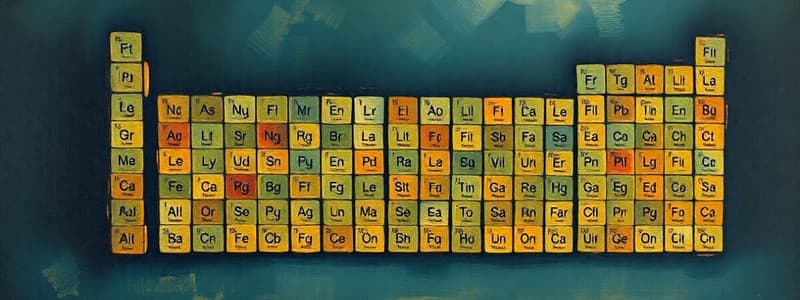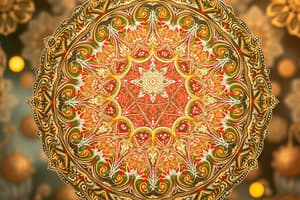Podcast
Questions and Answers
Why are lithium and sodium both categorized as Group 1 elements?
Why are lithium and sodium both categorized as Group 1 elements?
- They both have a full outer electron shell.
- They both have one electron in their outer shell. (correct)
- They both readily gain an electron.
- They both have similar atomic masses.
What was a key reason Mendeleev left gaps in his periodic table?
What was a key reason Mendeleev left gaps in his periodic table?
- He was trying to reduce the size of the table for printing purposes.
- He knew all the elements, but didn't have space to write them all.
- He was unsure about the atomic masses of several known elements.
- He anticipated the discovery of new elements with specific properties. (correct)
Why is sodium more reactive than lithium?
Why is sodium more reactive than lithium?
- Sodium has fewer electron shells, resulting in a stronger attraction to the nucleus.
- Sodium loses its outer electron more easily due to greater shielding. (correct)
- Lithium is a liquid at room temperature, which inhibits its reactivity.
- Lithium has a higher atomic mass, decreasing its desire to react.
Why is hydrogen's placement in Group 1 of the periodic table sometimes considered an exception?
Why is hydrogen's placement in Group 1 of the periodic table sometimes considered an exception?
What observation would a student likely make when lithium reacts with water?
What observation would a student likely make when lithium reacts with water?
Why do Group 1 metals exhibit similar chemical reactions with water?
Why do Group 1 metals exhibit similar chemical reactions with water?
Which statement accurately describes the trend in reactivity of Group 1 metals as you move down the group?
Which statement accurately describes the trend in reactivity of Group 1 metals as you move down the group?
When sodium reacts with oxygen to form sodium oxide, what occurs?
When sodium reacts with oxygen to form sodium oxide, what occurs?
Why is chlorine more reactive than bromine?
Why is chlorine more reactive than bromine?
How are elements arranged in the modern periodic table?
How are elements arranged in the modern periodic table?
Fluorine has the lowest boiling point. How do the boiling points of halogens change as you move down the group from fluorine to iodine?
Fluorine has the lowest boiling point. How do the boiling points of halogens change as you move down the group from fluorine to iodine?
Why does chlorine displace bromine from sodium bromide?
Why does chlorine displace bromine from sodium bromide?
What happens to a lithium atom when it reacts with chlorine?
What happens to a lithium atom when it reacts with chlorine?
Which of the following is a property that distinguishes transition metals from alkali metals, making them more suitable for pipes used to transport water.
Which of the following is a property that distinguishes transition metals from alkali metals, making them more suitable for pipes used to transport water.
Which two metals react vigorously with water.
Which two metals react vigorously with water.
Potassium is more reactive than lithium, why?
Potassium is more reactive than lithium, why?
When sodium is added to water you can visibly see.
When sodium is added to water you can visibly see.
What happens to sodium and oxygen when sodium oxide is produced?
What happens to sodium and oxygen when sodium oxide is produced?
Name one element in period 4 of the periodic table that was not discovered by 1869
Name one element in period 4 of the periodic table that was not discovered by 1869
What are the two properties shared by the element in group 1?
What are the two properties shared by the element in group 1?
Flashcards
Elements in Period 4 undiscovered by 1869
Elements in Period 4 undiscovered by 1869
Noble gases and Group one elements.
Mendeleev's predictions
Mendeleev's predictions
Predicted if they were metals and their chemical properties.
Why lithium and sodium are in group 1
Why lithium and sodium are in group 1
Both lithium and sodium have one electron on the outer shell.
Why sodium is more reactive than lithium
Why sodium is more reactive than lithium
Signup and view all the flashcards
Why hydrogen shouldn't be in column 1
Why hydrogen shouldn't be in column 1
Signup and view all the flashcards
One other element in Group 2
One other element in Group 2
Signup and view all the flashcards
Why did Mendeleev left gaps
Why did Mendeleev left gaps
Signup and view all the flashcards
Group 1 metals
Group 1 metals
Signup and view all the flashcards
Group 1 electronic structure
Group 1 electronic structure
Signup and view all the flashcards
Two properties of Group 1 Metals
Two properties of Group 1 Metals
Signup and view all the flashcards
Why Potassium is more reactive than sodium
Why Potassium is more reactive than sodium
Signup and view all the flashcards
Modern periodic table: arrangement by protons
Modern periodic table: arrangement by protons
Signup and view all the flashcards
Modern periodic table: arrangement by electrons
Modern periodic table: arrangement by electrons
Signup and view all the flashcards
Transition elements vs alkali metals for water pipes
Transition elements vs alkali metals for water pipes
Signup and view all the flashcards
Reactivity of the alkali metals (group 1)
Reactivity of the alkali metals (group 1)
Signup and view all the flashcards
Boiling points of the halogens
Boiling points of the halogens
Signup and view all the flashcards
Why did Mendeleev leave gaps
Why did Mendeleev leave gaps
Signup and view all the flashcards
Newlands and Mendeleev arrangement in periodic tables
Newlands and Mendeleev arrangement in periodic tables
Signup and view all the flashcards
Fluorine
Fluorine
Signup and view all the flashcards
One other difference between the properties of copper and potassium.
One other difference between the properties of copper and potassium.
Signup and view all the flashcards
Study Notes
- Group one, which contains noble gases, includes elements in Period 4 that remained undiscovered by 1869.
- Mendeleev predicted undiscovered elements would be metals with specific chemical properties.
- Lithium and sodium are in group 1 because both have one electron in their outer shell.
- Sodium is more reactive than lithium because it loses its outer electron more easily and has more shielding.
- Hydrogen should not be placed in column 1, as it is a non-metal.
- Magnesium is another element found in Group 2.
- Sodium (Na) is an alkali metal, while Nickel (Ni) is a transition metal.
- Mendeleev left gaps to accommodate undiscovered elements in his periodic table.
- Lithium reacts with water to produce lithium hydroxide and hydrogen.
- Lithium floats on water during the reaction.
- Bubbles and lithium moving on the water's surface are two other observations during the reaction of lithium and water.
- All Group 1 metals display similar reactions with water.
- Group 1 metals have one electron in their outer shell in terms of electronic structure.
- Group 1 metals react with oxygen and have low melting points.
- Potassium is more reactive than sodium because potassium atoms are larger, and their outer shell is less strongly attracted to the nucleus.
- The modern periodic table arranges elements by proton number.
- The number of electrons increases across the period in the modern periodic table.
- Transition elements are stronger and have higher melting points than alkali metals, making them suitable for water pipes.
- Reactivity increases down Group 1 because the outer shell is further from the nucleus, and the outer electron is lost more easily.
- Lithium (Li) and potassium (K) are the two metals that react vigorously with water.
- The boiling points of halogens increase from fluorine to iodine down the group.
- Chlorine displaces bromine from sodium bromide because it is more reactive.
- Mendeleev left gaps to allow elements with similar properties to be placed together.
- Lithium, sodium, and potassium are in Group 1 because they all have one electron in their outer shell.
- Sodium (Na) is an alkali metal, copper (Cu) is a transition metal, and carbon (C) is a Group 4 element.
- Newlands and Mendeleev organized elements by atomic mass in their periodic tables.
- Fluorine has the lowest boiling point among the halogens.
- Copper is stronger than potassium.
- Reactivity increases from lithium to rubidium in Group 1 and decreases from fluorine to iodine in Group 7 due to relative distance from the nucleus, attraction to the nucleus, and ease of electron gain or loss.
- When sodium is put into water, bubbles and fizzes can be seen, and the sodium moves.
- Chlorine is more reactive than bromine because it has a smaller atom, less shielding, and can gain an electron more easily.
- A potassium atom is larger than a sodium atom.
- Argon has 18 protons and 22 neutrons.
- Argon is unreactive because it has eight electrons in its outer shell.
- Lithium forms positive ions, and chlorine forms negative ions when they react.
- Potassium has more shells and can lose an outer electron more easily than lithium, explaining why it is more reactive.
- A sodium atom loses one electron, and an oxygen atom gains two electrons when sodium reacts with oxygen to produce sodium oxide.
- Chlorine is more reactive than bromine because it has fewer shells, its outer shell is closer to the nucleus, and it gains electrons more easily.
- Sodium (Na) is a Group 1 element, and iron (Fe) is a transition metal.
- Besides floating, sodium melts, and the color of the indicator darkens when sodium reacts with water.
Studying That Suits You
Use AI to generate personalized quizzes and flashcards to suit your learning preferences.




